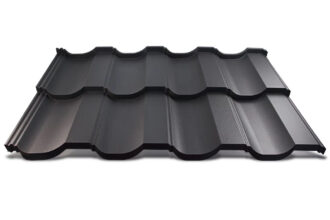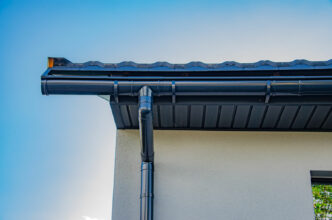Roofing replacement – when and how to do it legally?
Regardless of the quality of the work and the materials used, every roof needs to be replaced sooner or later. This is usually due to years of weathering or a single event, such as a violent storm or gusty windstorm. Find out how to replace your roofing in accordance with current legislation.
When is roofing replacement necessary?
Roofing replacement is unavoidable when there is damage that leads to leaks. In this case, you should ask a specialist to assess the condition of the roof trusses. If the roof’s substructure is soggy, mouldy or damaged by insects, it must be repaired or replaced immediately. A damaged wooden structure can start to crack, posing a direct threat to the life and health of the building’s occupants. Only when the roof trusses have been put in proper condition can you start replacing the roof.
The roof sheathing must meet building code requirements to not endanger occupants. Any sagging or mechanical damage caused by random events is a clear indication to seek professional help to replace the roofing. Renovating the façade or converting the attic into usable space may also require replacing the roof. In the first case, because of the visual coherence of the entire building, and in the second, because of the provision of adequate thermal insulation in the attic.
Roofing replacement and formal issues
Have you decided to replace the roof sheathing but are not sure what the formalities are? Building legislation clearly defines the work that must be notified, so it is not complicated. A few key actions are most commonly carried out on a roof.
- Ongoing maintenance includes any repairs to the roofing that involve the use of non-original materials. These activities do not need to be reported anywhere. They can be carried out at any time.
- Renovation – under current law, renovation is defined as: “construction work on an existing building that consists of restoring the building to its original condition and is not continuous maintenance, while the use of building materials other than those used in the original condition is permitted.” If all the repair work is done on your property, you don’t have to report it.
- Reconstruction – this term refers to any construction work that results in a change in the technical or performance characteristics of a structure. In the case of a roof, reconstruction includes replacing a structure or strengthening a roof and requires a permit. Importantly, replacing the roof sheathing is not considered reconstruction.
Replacement of roofing in a detached house
In theory, replacing the roof covering on a detached house does not require a notification. However, there are exceptions to this rule. Above all, the type of development is key. For detached houses that are within the required distance from the boundary of the neighbouring plot (4 m or 3 m in the case of walls without windows and doors), the replacement of the roof covering does not need to be notified. The issue becomes more complicated for popular semi-detached houses. A building permit is required to build a terraced house. Because of this, the replacement of roof sheathing for this type of building should be notified.
Be sure to consult the zoning plan before replacing the roof covering. It often contains instructions on the roof’s colour, appearance and shape.
Where to report a roof sheathing replacement?
If the replacement of the roofing needs to be notified, a permit must be applied for at the district or municipal office. This is usually the case when replacing the sheathing on one side of a semi-detached house. Notification of planned works must be submitted to the authority at least 21 days before the work is due to start. Importantly, you have 2 years from the time of application to replace the roofing if you obtain a permit. If you do not carry out the necessary work within this time, you will need to reapply for a permit.
Replacement of roofing also requires notification for buildings listed on the register of historic buildings. In this case, the roof renovation requires the permission of the provincial conservation officer. Replacing roof cladding also requires notification if the building is listed on the Register of Historic Buildings.
What is the penalty for replacing a roof without a permit?
Where notification of the replacement of the covering is necessary, the following penalties apply for failure to comply with the formalities:
- call for relevant documents;
- a fine of PLN 20-5 000 for arbitrary construction (following the amendment to the Building Act in 2022, arbitrary construction is not a criminal offence but only a misdemeanour, as a result of which the maximum fine has been significantly reduced);
- an order to dismantle the roof and restore it to its original state.
Roofing replacement step by step
Replacing the roofing does not necessarily involve replacing or even renovating the entire structure. If the roof trusses are in good condition, nothing will stop you from replacing the roofing with new material. Ensure that the new material you want to use matches the parameters of the gratings before replacing the truss. A ceramic tile, for example, is considerably heavier than sheet roofing. If you will be looking to change the material, make sure the truss will be able to support the load. Otherwise, you will expose the roof to numerous defects and even collapse.
Where should you start? First, by removing the old material. Once this has been done, protect the roof from the rain. A sealed tarpaulin is best used for this purpose. Once the roof structure is exposed, check the thermal and moisture insulation state. If your roof has no such insulation and you want to insulate the attic, install a vapour-permeable membrane. This will keep the space protected from water. Of course, replacing the roofing yourself is only possible if you have the necessary skills, tools and experience. Otherwise, hire a professional roofer to ensure the work is done correctly.
What type of roofing material should you choose?
Popular materials you can use for roofing include ceramic tiles, flat or corrugated sheet metal, bituminous felt or sheet roofing. The latter material is very versatile, and its main advantages include the following:
- lightweight – thanks to its low weight, it can be used in almost any building, regardless of the rafter structure;
- low cost – sheet roofing is much cheaper than classic roofing tile and visually, they are very similar;
- easy installation – especially in the case of modular sheet roofing, which are sold as prefabricated sheets;
- high aesthetics and a wide range of colours.
Are you looking for quality sheet roofing that not only protects but also decorates your home? Check out our offer and choose the variant that best meets your expectations!


